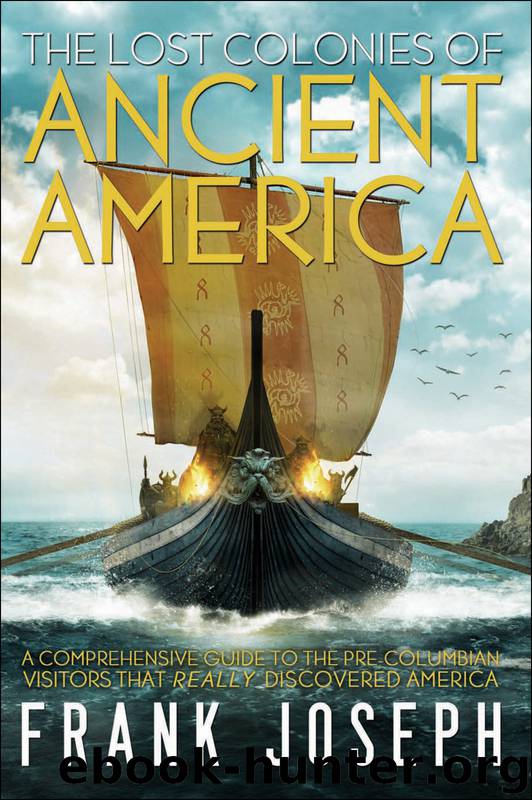The Lost Colonies of Ancient America by Frank Joseph

Author:Frank Joseph
Language: eng
Format: epub
Publisher: Red Wheel/Weiser
Published: 2014-04-14T16:00:00+00:00
Chapter 9
Japanese
The first Americans were Asians from Siberia who crossed a land-bridge over the Bering Sea into Alaska some 12,000 or more years ago. This central tenet in the belief system of mainstream archaeology was apparently borne out by Dr. Theodore Schurr of the Southwest Foundation for Biomedical Research in San Antonio, Texas. During the summer of 2008, he presented members of the American Association for the Advancement of Science with new information concerning the earliest peopling of the Americas. The DNA cells in present-day Native American Indians revealed their ancestral migration patterns in four major lineages going back to Siberia and northeast Asia, just as orthodox scholars have long argued.
However, Dr. Schurr’s “power packs” identified a fifth, previously unknown, and older lineage. This “haplogroup X” is diagnostic of Western Europeans, not Asians, and occurs among most Algonkian-speaking tribes, such as the Ojibwa. “These data imply that haplogroup X was present in the New World long before [modern] Europeans first arrived in the New World,” he said, “before Columbus, or the Vikings, or anybody else,” about 30,000 years ago.1
His research confirmed studies made public eight years before by C. Loring Brace, a University of Michigan professor of anthropology, who “influenced a generation of anthropological research into human evolution.”2 In February 2000, he presented a craniofacial perspective on the origins of today’s Native American Indians to an annual meeting of the American Association for the Advancement of Science, in Washington, D.C. Brace explained how he used “morphometric comparisons of thousands of ancient and modern skulls, measuring each one as part of a comparative craniometric survey to identify the Old World roots of Native Americans.”3
For the previous 20 years, he and colleagues from the University of Wyoming, the Chinese Academy of Sciences in Beijing, the Chengdu College of Traditional Chinese Medicine (Sichuan province), and the Mongolian Academy of Sciences, in Ulanbatar, subjected the skulls to a regimen of two dozen measurements apiece, providing each one with a dendrogram (a tree-like figure wherein the distance between its twigs reflects the closeness or distance between any given group from other groups). According to the editors of the University of Michigan’s News Releases, Professor Brace’s “studies show that descendants of the first humans to enter the New World, including natives of Mexico, Peru, and the southern United States, have no obvious ties to any Asian groups.”4
Instead, the Blackfoot, Iroquois, and other tribes from Minnesota, Michigan, Ontario, and Massachusetts are “descended from the Jōmon. The Inuit appear to be a later branch from that same Jōmon trunk. Tribal groups who lived down the eastern seaboard into Florida share this origin, according to Brace.”5 He told how
human cranio-facial data were used to assess the similarities and differences between recent and prehistoric Old World samples, and between these samples and a similar representation of samples from the New World. The first entrants into the Western Hemisphere of maybe fifteen thousand years ago gave rise to the continuing native inhabitants south of the U.S.-Canadian border. These show no close association with any known mainland Asian population.
Download
This site does not store any files on its server. We only index and link to content provided by other sites. Please contact the content providers to delete copyright contents if any and email us, we'll remove relevant links or contents immediately.
| Ancient & Controversial Knowledge | Ghosts & Hauntings |
| Hermetism & Rosicrucianism | Magic Studies |
| Occultism | Parapsychology |
| Supernatural | UFOs |
| Unexplained Mysteries |
Animal Frequency by Melissa Alvarez(4154)
Sigil Witchery by Laura Tempest Zakroff(4029)
Real Magic by Dean Radin PhD(3924)
Fingerprints of the Gods by Graham Hancock(3738)
Journeys Out of the Body by Robert Monroe(3461)
Aleister Crowley: The Biography by Tobias Churton(3427)
The Rosicrucians by Christopher McIntosh(3371)
Alchemy and Alchemists by C. J. S. Thompson(3296)
Mysteries by Colin Wilson(3251)
Hitler's Monsters by Eric Kurlander(3164)
The Hatha Yoga Pradipika (Translated) by Svatmarama(3075)
John Dee and the Empire of Angels by Jason Louv(3046)
Wicca: a guide for the solitary practitioner by Scott Cunningham(3043)
Infinite Energy Technologies by Finley Eversole(2832)
Dark Star Rising by Gary Lachman(2740)
The Book of Lies by Aleister Crowley(2721)
Book of Life by Deborah Harkness(2720)
Aliens by Jim Al-Khalili(2704)
To Light a Sacred Flame by Silver RavenWolf(2674)
